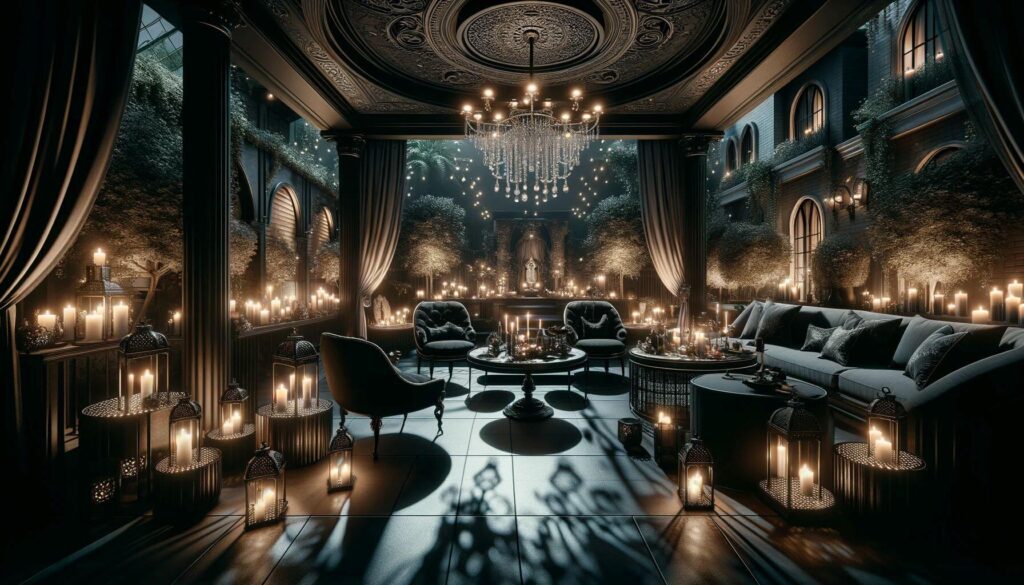
Gothic architecture, with its soaring spires and intricate details, can bring a touch of medieval elegance to your outdoor space. Creating a gothic-inspired patio allows you to blend historical charm with modern comfort. Let’s explore some ways to infuse your patio with gothic architectural elements.
Start with Gothic-Style Arches

The pointed arch is a hallmark of gothic design. Consider adding arched entryways or windows to frame your patio space. You could install an arched trellis for climbing plants or create an arched doorway leading from your home to the patio. These graceful curves will immediately evoke a gothic atmosphere.
For a bold statement, build a stone archway as the focal point of your patio. Use reclaimed stones or faux stone veneers to achieve an aged look. Train vines to grow over the arch for a romantic, overgrown effect reminiscent of ancient ruins.
Incorporate Intricate Stonework
Gothic architecture is known for its elaborate stone carvings and patterns. While you may not want to carve an entire stone patio, you can incorporate decorative stonework in key areas. Consider adding carved stone benches, planters, or wall panels with gothic motifs like trefoils or quatrefoils.
For a more subtle touch, use patterned concrete stamps or stencils to create gothic-inspired designs on your patio floor. Geometric patterns or faux stone textures can mimic the look of medieval stone pavers.
Add Vertical Elements with Columns and Pillars
Gothic structures emphasize height and vertical lines. Bring this feeling to your patio by adding slender columns or pillars. Use these to support a pergola or to frame seating areas. Choose columns with fluted details or carved capitals for an authentic gothic look.
For a modern twist, consider using wrought iron columns with gothic-inspired scrollwork. These can support lighting fixtures or planters while maintaining an airy feel.
Install Gothic-Style Lighting Fixtures

Lighting plays a crucial role in setting the mood for your gothic patio. Look for lantern-style fixtures with pointed arches and decorative metalwork. Wall sconces shaped like torches can evoke a medieval castle atmosphere.
For a dramatic effect, install a wrought iron chandelier over your outdoor dining area. Choose one with candle-style bulbs for a flickering, romantic glow. Solar-powered options are available if you don’t have outdoor electrical wiring.
Use Gothic Color Palettes
Gothic architecture often features rich, deep colors. Paint nearby walls or fences in dark hues like burgundy, forest green, or midnight blue. These colors create a moody backdrop for your patio elements.
Contrast these dark tones with lighter accents in stone gray or cream. Use these lighter colors for furniture cushions, planters, or decorative tiles to prevent the space from feeling too heavy.
Incorporate Pointed Finials and Spires
Finials and spires are distinctive features of gothic architecture. Add these pointed elements to the tops of fence posts, gazebos, or even planters. You can find decorative finials at many garden centers or create your own using wood or metal.
For a playful touch, paint birdhouses to resemble miniature gothic cathedrals, complete with tiny spires. Place these around your patio to add whimsical height and interest.
Create Gothic-Inspired Planters and Gardens

Gothic architecture often incorporated gargoyles and grotesques as decorative elements. While full-sized gargoyles might be too intense for most patios, you can nod to this tradition with smaller statues or planter faces.
Plant flowers and herbs that were common in medieval gardens. Lavender, rosemary, and sage not only look beautiful but also provide fragrant touches to your gothic patio. Train climbing roses or ivy up trellises to soften hard architectural elements.
Add Decorative Ironwork
Wrought iron is a versatile material that fits perfectly with gothic design. Use decorative iron gates, railings, or screens to define different areas of your patio. Look for pieces with pointed arches, trefoils, or other gothic motifs.
For a cozy seating area, choose wrought iron furniture with scrollwork details. Add plush cushions in rich fabrics like velvet or brocade to balance the metal’s coolness.
Install Stained Glass Elements
While you can’t recreate a full gothic cathedral window on your patio, you can incorporate smaller stained glass elements. Hang stained glass panels in arched frames to create colorful focal points. These can be especially striking when backlit by the sun.
For a modern take, use colored acrylic or plexiglass panels in gothic-inspired shapes. These can serve as privacy screens or wind barriers while adding a pop of color to your patio.
Consider Water Features with Gothic Flair

Water features were common in medieval gardens and can add a sense of tranquility to your gothic patio. Look for fountains with pointed arches or tiered designs reminiscent of gothic architecture. The sound of trickling water will enhance the peaceful atmosphere of your outdoor space.
For a dramatic centerpiece, install a wall fountain with a gargoyle or grotesque face as the water spout. Surround it with lush plantings to create a secluded, romantic nook.
By incorporating these gothic architectural elements, you can transform your patio into a unique and enchanting outdoor retreat. Remember, the key is to balance historical inspiration with modern functionality. Mix gothic features with comfortable seating and practical amenities to create a space that’s both visually stunning and enjoyable for everyday use.
Whether you embrace full gothic drama or just add a few subtle touches, your patio will stand out as a testament to this timeless architectural style. With careful planning and creative design, you can bring the majesty of gothic cathedrals to your own backyard oasis.



